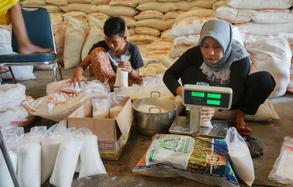 Indonesians repack sugar into smaller packaging before selling it to customers in Tangerang, Banten on April 3, 2020. (FAJRIN RAHARJO / AFP)
Indonesians repack sugar into smaller packaging before selling it to customers in Tangerang, Banten on April 3, 2020. (FAJRIN RAHARJO / AFP)
ROME - World food prices fell for a third consecutive month in April, hit by the economic and logistical impact of the coronavirus pandemic, the United Nations food agency said on Thursday.
“The pandemic is hitting both the demand and supply sides for meat, as restaurant closures and reduced household incomes lead to lower consumption and labor shortages on the processing side are impacting just-in-time production systems,” said FAO Senior Economist Upali Galketi Aratchilage
The Food and Agriculture Organization (FAO) food price index, which measures monthly changes for a basket of cereals, oilseeds, dairy products, meat and sugar, averaged 165.5 points last month, down 3.4 percent on March.
The FAO sugar price index fell to a 13-year low, plunging 14.6 percent from March, with the coronavirus crisis hitting demand and tumbling crude oil prices also reducing the need for sugarcane to produce ethanol, the Rome-based agency said.
ALSO READ: Virus-spurred slowdown in Japan prices sparks deflation fears
The vegetable oil price index fell 5.2 percent, hit by falling palm, soy and rapeseed oil values, while the dairy index dropped 3.6 percent, with butter and milk powder prices posting double-digit declines.
The meat index shed 2.7 percent, with a partial recovery in import demand from China failing to balance a slump in imports elsewhere. FAO also said major producing countries suffered logistical bottlenecks, while coronavirus lockdowns in many nations had caused a sharp fall in sales.
“The pandemic is hitting both the demand and supply sides for meat, as restaurant closures and reduced household incomes lead to lower consumption and labor shortages on the processing side are impacting just-in-time production systems,” said FAO Senior Economist Upali Galketi Aratchilage.
ALSO READ: UN : World food prices fall sharply on epidemic, oil slump
By contrast with the other indices, FAO’s cereal price index declined only slightly, as international prices of wheat and rice rose significantly while those of maize dropped sharply.
Rice prices rose 7.2 percent from March, due in large part to temporary export restrictions by Vietnam that were subsequently repealed, FAO said. Wheat prices rose 2.5 percent amid reports of a quick fulfillment of the export quota from Russia.
However, prices of coarse grains, including maize, fell 10 percent, hit by reduced demand for both animal feed and biofuel production.
FAO held its forecast for cereal production largely steady at 2.720 billion tonnes in 2019, but reduced its forecast for cereal utilisation in 2019/20 by 24.7 million tonnes, mainly because of the impact of the coronavirus on the economy.
FAO also unveiled its first forecasts for global wheat supply and demand in the 2020/21 marketing season, predicting world production at 762.6 million tonnes, broadly in line with the 2019 level.
It said it expected smaller harvests in the European Union, north Africa, Ukraine and the United States. This would be largely offset by larger harvests in Australia, Kazakhstan, Russian and India.
READ MORE: The poor face food crisis amid pandemic
Global wheat utilisation in 2020/21 was expected to be stable, with anticipated increases in food consumption outweighing reductions in feed and industrial uses.



